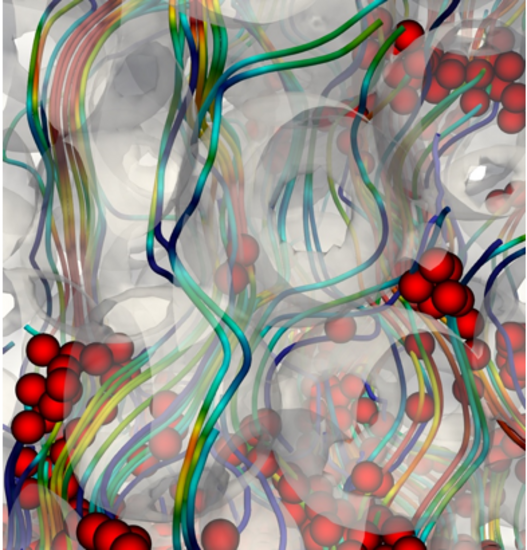ENGINEERING AND CFD
Particle Transport in Porous Media
Principal Investigator:
Dr. Qingguang Xie
Affiliation:
Helmholtz-Institut Erlangen-Nürnberg für Erneuerbare Energien, Nürnberg, Germany
Local Project ID:
papos
HPC Platform used:
JUWELS Cluster at JSC
Date published:
Nanoparticles (NPs) play an important role in various applications, such as drug delivery, detection of proteins, photocatalysis and optics. The size of the NPs are crucial parameters that significantly impact their properties. Therefore, samples of monodisperse NPs are highly desired. However, achieving homogeneous batches of NPs during fabrication is a challenge. The self-assembly methods used for nanoparticle formation inherently result in higher heterogeneity due to the complex thermodynamics and kinetics involved. Therefore, it is necessary to develop methods and techniques for the size-based separation and purification of NPs after their assembly. Size exclusion chromatography has been established as a promising approach for separating NPs based on their size dependent hydrodynamic behavior in porous media. Yet, a comprehensive understanding of particle transport mechanisms in chromatographic columns is still lacking, which is however essential for designing optimal columns and for improving separation efficiency.
Observing nanoparticle transport in porous media experimentally presents significant challenges due to the extremely small pore sizes, often on the nanometer scale, and the lack of transparency in typical columns used for such studies. Computer simulations offer a valuable alternative by enabling researchers to model and analyze particle transport within these complex systems in detail. A team of physicists from the Helmholtz Institute Erlangen-Nürnberg conducted state-of-the-art simulations to gain a deeper understanding of particle transport in porous media. The simulation was performed using a hybrid method combining a lattice Boltzmann solver for the fluid flow with a discrete element method for the suspended particles. They acquired reconstructed X-ray tomography data of a realistic porous structure, synthesized by their experimental collaborators, and incorporated the data into the simulations.
Thanks to this advanced approach and the computational resources available on the JUWELS Cluster, the research is capable of capturing all the key factors that influence particle transport in porous media. This includes not only the specific properties of the particles themselves-such as size and shape-but also the particle-particle interactions, and the interaction between particle and the individual pores of the medium.
The team is able to track the trajectory of each individual particle as it moves through the porous media, providing detailed insights into the factors that influence their passage time. This includes the effects of particle size and particle-pore interactions. Additionally, they identified specific locations within the media where particles tend to become clogged or even jam. These clogging and jamming events have a significant impact on the flow dynamics, which were reflected in the probability distribution of flow velocities.
Future work will extend these studies to explore the transport and separation of polydisperse particles in porous media. Ultimately, this research will provide guidance on how to design optimized pore geometries and how to tailor particle-particle and particle-pore interactions to improve performance in applications such as chromatography and other separation technologies.

The image shows the streamlines and the trajectories of particles that are transported by a fluid flow inside a porous medium. The colors of the streamlines and trajectories depict the flow velocities.